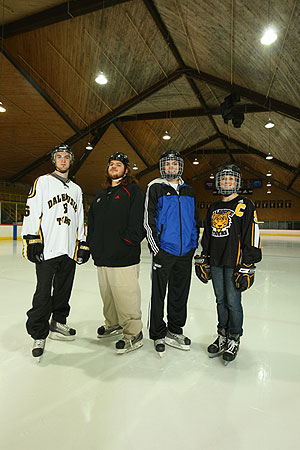 |
| Daniel Bartek (Men's Hockey), Aidan Rafuse (Staff), Jocelyn LeBlanc (Staff and Women's Hockey), Laura Shearer (Women's Hockey) wear helmets in support of the new rule at AVĺ„ņ÷≤Ņ. (Nick Pearce Photo) |
That‚Äôs because, as of January 1, 2010, it will be mandatory for all participants, regardless of age, to wear CSA-approved hockey helmets during all skating sessions held at AVĺ„ņ÷≤Ņ. Memorial Arena is the first facility of its kind in Nova Scotia to make helmets mandatory for all age groups at public skates and for ice rentals, a decision intended to assist in the prevention and reduction of head and brain injuries.
The change was prompted by observations from Dr. David B. Clarke, a AVĺ„ņ÷≤Ņ professor and one of the leading neurosurgeons in the province. ‚ÄúHe was appalled that even our staff didn‚Äôt have helmets on,‚ÄĚ says Kathie Wheadon-Hore, Senior Manager, Facility Operations for AVĺ„ņ÷≤Ņ‚Äôs Department of Athletics and Recreational Services.
Although helmet use is mandatory for cyclists, skateboarders and in-line skaters under the Motor Vehicle Act, there is no such ruling in place for helmet use while ice skating. Research shows, however, that ice skating is found to produce three times as many head injuries than any of these aforementioned road-related activities due to the hard and slippery surface of the ice. When a person loses his or her balance and falls, there is often impact of the head directly on the hard surface.
In general terms, when a person falls and strikes his or her head while wearing a helmet, the helmet is designed to prevent direct impact to the skull and spread that impact over a larger area. It should also help to prevent cuts or bruising to the head’s surface and, in severe cases, prevent the skull from being fractured. Helmets are also meant to help the head slow down more gradually in the case of a fall, as it typically stops moving very quickly when it comes in contact with a hard surface. This can cause the brain to strike the inside of the skull and can permanently damage the sensitive connections between brain cells.
‚ÄúWearing a helmet while skating in order to protect your brain is supported by research and also just makes common sense. We want people to enjoy this wonderful activity and, at the same time, we want people to protect their brains. I am delighted that AVĺ„ņ÷≤Ņ is taking a leadership role on this issue,‚ÄĚ says Dr. Clarke.
‚ÄúBrain injuries are extremely stressful to live through, as patients and their families are often devastated to learn that their lives will never be the same again,‚ÄĚ says Lynne Fenerty, a critical care and research nurse with the Division of Neurosurgery at the QEII Health Sciences Centre.
“Brain injuries commonly have permanent lifelong consequences, such as headaches, double vision and difficulties with smell, taste, memory, and changes in personality, just to name a few. We have seen people who suffer a simple slip or trip on ice which results in a minor injury to the brain but really translates into major consequences for the patient to manage on a daily basis.“
Ms. Wheadon-Hore recognizes this policy will spark some debate. She wants to impress, however, that this decision was made after much careful thought, consideration and research and that Dr. Clarke and his research coordinators have been working diligently with AVĺ„ņ÷≤Ņ on the helmet issue since the beginning of the summer.
In anticipation of this policy coming into effect, two fourth-year students from AVĺ„ņ÷≤Ņ‚Äôs School of Nursing and nursing staff from Capital Health‚Äôs joint QEII/IWK/AVĺ„ņ÷≤Ņ Division of Neurosurgery Neuro-Trauma and Injury Prevention Programs have been on-hand during public skates to help educate those in attendance about the seriousness of head injuries and provide answers to questions from concerned parents.
Lisa Sangster, one of the nursing students, finds that, ‚Äúeveryone is supportive and very interested in the brain injury display information that we have been providing during the skates.‚ÄĚ The display‚Äôs main draws have been the anatomical and Jell-o models of the brain, which demonstrate the softness of the organ and the thinness of the skull.
‚ÄúWhile most of the comments have been very positive to date, that parents with large families have expressed concern for the initial cost of helmets,‚ÄĚ says Jessica Heaton, another nursing student.¬†In an attempt to counteract this barrier, Capital Health‚Äôs Division of Neurosurgery has agreed to support participants in Memorial Arena‚Äôs public skates with discount coupons for helmets purchased from a local retailer for a period of time.
Ms. Wheadon-Hore also acknowledges that no helmet can protect against all possible injuries but says, ‚ÄúWe have to do this. Even if this helps save one person, if it helps save one of our students, then it‚Äôs worth it in my opinion.‚ÄĚ
